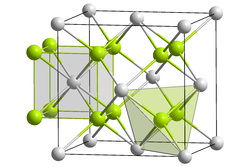Cobalt disilicide
| Crystal structure | |||||||||||||
|---|---|---|---|---|---|---|---|---|---|---|---|---|---|

|
|||||||||||||
| __ Co 2+ __ Si - | |||||||||||||
| General | |||||||||||||
| Surname | Cobalt disilicide | ||||||||||||
| other names |
|
||||||||||||
| Ratio formula | CoSi 2 | ||||||||||||
| Brief description |
gray odorless solid |
||||||||||||
| External identifiers / databases | |||||||||||||
|
|||||||||||||
| properties | |||||||||||||
| Molar mass | 115.11 g mol −1 | ||||||||||||
| Physical state |
firmly |
||||||||||||
| density |
5.3 g cm −3 |
||||||||||||
| Melting point |
1277 ° C |
||||||||||||
| solubility |
practically insoluble in water |
||||||||||||
| safety instructions | |||||||||||||
|
|||||||||||||
| As far as possible and customary, SI units are used. Unless otherwise noted, the data given apply to standard conditions . | |||||||||||||
Cobalt disilicide is a chemical compound of cobalt from the group of silicides .
Extraction and presentation
Cobalt disilicide can be obtained by reacting cobalt with silicon .
properties
Cobalt disilicide is a gray, odorless solid that is practically insoluble in water. It has a cubic crystal structure of the fluorite type with the space group Fm 3 m (space group no. 225) .
use
Cobalt disilicide is widely used in chemical research.
In microelectronics and microsystem technology , cobalt silicide is used for low-resistance contacting of silicon in the production of highly integrated circuits (VLSI) in 250 nm to 90 nm technology. It initially replaced the common titanium disilicide , but from the 90 nm technology node onwards, due to physical disadvantages, it was increasingly replaced by dinickel silicide (see salicide process ).
Related links
In addition to cobalt disilicide, at least three other cobalt silicides are known: the orthorhombic Co 2 Si , the cubic CoSi and the cubic CoSi 3 . Two more, Co 5 Si 3 and Co 3 Si, have not yet been investigated in detail.
Individual evidence
- ↑ a b c d e f g h i data sheet Cobalt silicide, 99% (metals basis) from AlfaAesar, accessed on July 5, 2016 ( PDF )(JavaScript required) .
- ^ A b Lih J. Chen, Institution of Electrical Engineers: Silicide Technology for Integrated Circuits . IET, 2004, ISBN 978-0-86341-352-0 , pp. 78 ( limited preview in Google Book search).
- ^ EG Rochow: The Chemistry of Silicon Pergamon International Library of Science, Technology, Engineering and Social Studies . Elsevier, 2013, ISBN 978-1-4831-8755-6 , pp. 1360 ( limited preview in Google Book search).


